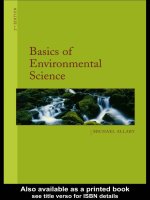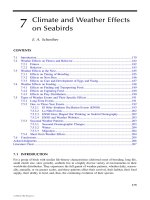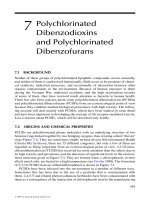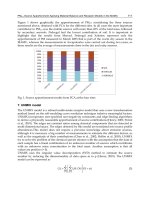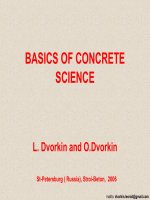BASICS OF CONCRETE SCIENCE - CHAPTER 7 pdf
Bạn đang xem bản rút gọn của tài liệu. Xem và tải ngay bản đầy đủ của tài liệu tại đây (386.45 KB, 19 trang )
CHAPTER 7
DESIGN OF NORMAL
CONCRETE MIXTURE
L. Dvorkin and O.Dvorkin
127
7.1. General and tasks
Design of concrete mixtures - the main technological problem, which decision
defines a level of operational reliability of constructions and degree of rational
use of the resources spent for their manufacturing and installation.
The founder of practical methodology of design of concrete mixtures is
D.Abrams. He summarized results of extensive experimental researches in
Chicago Laboratory of Portland cement Association and formulated the
primary tasks of design of concrete mixtures and methods of their decision.
In modern technology designing of concrete mixture means a
substantiation and choice of a kind of initial materials and their ratios
providing at set criterion of an optimality given requirements to a concrete
mix and concrete.
128
Actual directions of development of methodology of concrete mixtures design
are:
- increase in "predicting ability" of calculated methodology that is an opportunity
of full comsideration of technological factors and given requirements to
concrete;
- increase in efficiency of algorithms of concrete mixtures design, their
accuracy and speed.
In technological practice method of designing concrete mixtures with the
required compressive strength is the most common. Many properties of concrete
are simply linked with compressive strength such as flexural and tensile strength,
resistance to abrasion, etc. However, dependence between strength and frost-
resistance or strength and creep, etc. is not always straight proportional. Their
calculated determination must be based on the complex of the special
quantitative dependences.
Most developed and realized in practice there are 2-factor tasks, it means that
the given properties of concrete are compressive strength (R
cmp
) and
consistency of the mix (Slump or Vebe).
129
If there is a necessity in normalization of some other technical properties of
concrete, except for compressive strength, the problem of concrete mixtures
design becomes essentially complicated.
At designing mixtures of various and in particular special kinds of concrete
(hydrotechnical, road, etc.) there are multi-factors tasks. They can be divided
into three subgroups:
1- With the normalized parameters unequivocally connected with
compressive strength of concrete;
2- With the normalized parameters uncertainly connected with compressive
strength of concrete;
3 - With the normalized parameters which have been not connected with
compressive strength.
For example, tasks with various given parameters of strength of concrete
belong to the first subgroup. At calculation of compositions of such concrete
mixture the defining parameter from given properties of the concrete and its
corresponding compressive strength are determined and established
minimally possible cement-water ratio (C/W) which providing all set of
properties.
130
Fig. 7.1. Effect of cement-water ratio (C/W) on the
compressive strength (R
cmp
), flexural strength (R
fl
)
and splitting tensile strength (R
spl
)
C/W
R
spl
,
MPa
R
fl
,
MPa
R
cmp
,
MPa
For example, from Fig.
7.1 follows, that if are
normalized: compressive
strength R
cmp
≥ 20 MPa,
flexural strength R
fl
≥ 8,3
MPa and splitting tensile
strength R
spl
≥ 7,9 МПа,
that, obviously, the
defining parameter is R
spl
and necessary cement-
water ratio providing all
three parameters of
properties, is equal 2.1.
131
Normalized parameters in tasks of
the second subgroup of designing
concrete mixtures alongside with
compressive strength can be
creep, frost resistance, heat
generation, etc.
Fig. 7.2 shows the example of
relationship between creep and
quantity of the cement stone in
concrete at constant
compressive strength. At
constant water-cement ratio and
therefore concrete strength,
concrete creep can essentially
differ depending on quantity of
the cement stone in concrete.
Fig. 7.2. Effect of quantity of the cement stone in concrete
on the value of creep:
1 – Compressive strength of concrete = 20 MPa;
2 – Compressive strength of concrete = 30 MPa
Quantity of cement stone in concrete, kg/m
3
Value of creep at 28 days, C
m
10
6
132
For the tasks of concrete mixtures design of the third subgroup (for example,
light concrete) water-cement ratio is not a determinative factor, providing the
complex of the normalized properties. For such tasks is necessary to find
other, substantial for all normalized properties factor. Determination of
necessary value of this factor becomes the main task of concrete mixtures
design.
7.2. Selection of raw materials and admixtures
Task of a choice of initial materials is the technical and economic problem
defining efficiency of designed concrete mixtures and an opportunity of
achievement of demanded properties of concrete.
The basic technical parameters at a choice of a kind of cement are:
chemical composition, strength, rate of hardening, normal consistency and
fineness.
For an estimation of efficiency of use of cement the relative parameters
describing the quantity of cement or its cost on unit of strength and also
ratio between strength of concrete and the quantity of cement are offered.
133
Active mineral admixtures (pozzolans) are added directly in concrete mixes
and widely applied to economy of cement and their most power-intensive
component - cement clinker.
"Cementing efficiency" or amount of cement saved at adding active mineral
admixtures depends on many factors characterizing their composition,
structure, fineness, terms of hardening, age of concrete, etc.
The characteristic feature of a modern concrete technology is wide
application of chemical admixtures for achievement of necessary concrete
properties, declines of expense of financial and power resources at
making concrete and at its application for constructions.
Expenses for the admixture (E
xa
) at production of concrete can be
calculated as follows:
(7.1) ,ExACEx
adt
aaa
+=
Where C
a
- cost of the admixture per 1 m
3
of concrete including necessary
transport costs; A - the specific amount of the admixture;
adt
a
Ex
- the specific costs connected with additional processing of the
admixture, its storage, batching, change of the composition of
concrete mixture, etc.
134
For manufacturers of concrete (concrete mix, products and structures) is
important to distinguish the economic effect provided by the admixture due to
economy of other resources during manufacture and effect reached at concrete
application.
Expenses on admixture (E
xa
) at the production of concrete mix are justified, if
the following condition is executed:
(7.2) ,ExExExExEx
'
pr
'
ipria
−−+<
Where Ex
i
and Ex
i
' - expenses on initial materials of concrete mix without
admixture and with admixture; Ex
pr
and Ex
pr
' - other production expenses
on concrete mix without admixture and with admixture.
135
Additional possibilities are opened at the use in the formula of strength in
place of ordinary multiplicative coefficient pA.
7.3. Calculations of basic parameters
of concrete mixture composition
Calculation of cement-water ratio.
Most widely used formula for determination of cement-water ratio (C/W) is
following:
(
)
(7.3) ,5.0W/CАRR
ccmp
−
=
Where A- coefficient, specified in Table 7.1 depending on the different
factors; R
c
– strength of cement at 28 days, MPa; R
cmp
– compressive
strength of concrete at 28 days, MPa.
Equation of multiplicative coefficient pA can be presented as follows:
рА = А А
1
…А
i
…А
n
, (7.4)
Where А
i
is a coefficient, taking into account additional influence on the
value of strength of i-factor (i=1…n).
Ordinary technological information allows to take into account in the
multiplicative coefficient pA to 2 or 3 additional coefficients А
i
.
136
Value of coefficient A for concrete made
with the use of
Kind of
aggregates
Contents of harmful
substances (clay, silt, soft
particles) in crushed stone
(gravel) and sand, %
Crushed
stone
Gravel
mountain
Gravel river
and marine
Crushed stone
(gravel)
0
Sand 0
0.64 0.6 0.57
Crushed stone
(gravel)
0
Sand
3
0.61 0.56 0.53
Crushed stone
(gravel)
1
Sand 3
0.58 0.53 0.5
Crushed stone
(gravel)
2
Sand 3
0.55 0.5 0.47
Crushed stone
(gravel)
2
Sand
5
0.52 0.47 0.44
Table 7.1
Recommended values of coefficient A (from V.Sizov)
137
Additional possibilities for expansion of range of the decided tasks of
designing concrete mixtures are possible at the use of the “modified cement-
water ratio (C/W)
mod
”:
(7.5) ,
VW
DКC
)W/C(
air
e.c
mod
+
+
=
Where К
c.e
- coefficient of "cementing efficiency" of mineral admixtures, that
is content of cement in kg, commutable by 1 kg of mineral admixture: D -
content of mineral admixture, kg/m
3
; C and W – accordingly contents of
cement and water, kg/m
3
; V
air
- volume of the entrained air, liters per m
3
.
In this case, formula (7.3) can be presented as follows:
(7.6) .5.0
VW
DКC
pARR
air
e.c
ccmp
−
+
+
=
Where R
c
– strength of cement at 28 days, MPa; R
cmp
– compressive
strength of concrete at 28 days, MPa.
138
The coefficient of “cementing efficiency” can be easily defined from
experimental data for the concretes with identical strength by the following:
(7.7) ,
D
CC
K
21
e.c
−
=
Where C
1
- content of cement in the concrete without mineral admixture; C
2
- content of cement in the concrete with mineral admixture; D - amount of
mineral admixture.
Application of the “modified cement-water ratio” is rational and useful in
particular for the concrete mixtures design with the limited or small amount
of cement at adding of mineral admixtures.
Calculation of water content.
In practice of designing concrete mixtures the water content of concrete
mixtures is determined usually from empiric data by the graphs (Fig.7.3) or
tables which offer some base values of water content (kg/m
3
) depending on
the indexes of consistency of concrete mix and specified depending on the
features of initial materials. The rule of constancy of water content, in
accordance with which the water content for achievement necessary
consistency of concrete mix remains practically permanent in the certain
range of cement content or cement-water ratio, is widely used thus.
139
Fig. 7.3. Relationship between amount of water per cubic meter and slump
of concrete mix:
1 – Sand (Fineness modulus is equal 3); 2-9 – Granite crushed stone (Particle
sizes are 10, 15, 20, 30, 40, 60, 80 и 150 mm)
Slump,
cm
Amount of water, kg/m
3
140
Calculation of aggregates content.
One of basic tasks of optimization of concrete mixtures is determination of
aggregates ratio, which provides the minimum amount of cement.
Widely applied in Russia and Ukraine the calculation-experimental methods
of designing concrete mixtures, use the coefficient (α) which characterizes
filling of voids between crushed stone (gravel) particles with cement-sand
pastes (mortar) (taking into account some stock of the paste for
achievement demanded consistency of the concrete mix) for determination
of quantities of sand and crushed stone (gravel).
Quantities of coarse and fine aggregates can be easily defined by decision
of system of two equations of material balance. The first equation
expresses equality of volume of the concrete mix to the sum of absolute
volumes of the initial components of concrete, the second - conformity of
volume of the cement - sandy paste (mortar) to volume of voids in the
coarse aggregates (taking into account some stock of the paste for
achievement demanded consistency of the concrete mix):
141
Where C, W, F
ag
, C
ag
– accordingly quantities of cement, water, fine and
coarse aggregates, kg/m
3
; ρ
c
, ρ
w
, ρ
f.ag
и ρ
c.ag
– accordingly specific gravity
(weight per unit absolute volume of ingredients of concrete) of cement,
water, fine and coarse aggregates, kg per liter; Р
c.ag
– volume of voids in
coarse aggregates, including space between particles; ρ
b.c.ag
– bulk density
of coarse aggregates, kg per liter.
(7.8) ,
C
Р
F
WC
1000
CF
WC
ag.c.b
ag
ag.c
ag.f
ag
wc
ag.c
ag
ag.f
ag
wc
ρ
α=
ρ
+
ρ
+
ρ
=
ρ
+
ρ
+
ρ
+
ρ
(7.9) ,
1
1000
C
ag.c.b
ag.c
ag.c
ag
ρ
αρ
+
ρ
=
Therefore:
(
)
(7.10) . /C/W/C1000F
ag.fag.cagwcag
ρ
ρ
−
ρ
−
ρ
−
=
142
From Table 7.2 the coefficient α can be found.
Table 7.2
Coefficient α (plastic consistency of concrete mixes)
Value of α at water-cement ratio
Cement content,
kg/m
3
0.3 0.4 0.5 0.6 0.7 0.8
250 – – – 1.26 1.32 1.38
300 – – 1.3 1.36 1.42 –
350 – 1.32 1.38 1.44 – –
400 1.31 1.4 1.45 – – –
500 1.44 1.52 – – – –
600 1.52 1.56 – – – –
Notes: 1. Water demand of fine aggregates is equal 7%.
2. For stiff concrete mixes (C < 400 kg/m3) α = 1.05 1.15.
143
7.4. Correction of design concrete compositions
Inevitable deviations of actual indexes of properties of concrete mixes and
concretes from a calculated stipulate certain approximations of calculated
compositions of concrete. Adjustment of calculated compositions is made
experimentally in a laboratory. Depending on possibilities of testing laboratory
and terms of construction works, an amount of laboratory works at
experimental correction of composition of concrete can be different. Complete
adjustment can be at experimental correction of all parameters of concrete
mixture: water content, water-cement ratio, ratio between different aggregates,
volume of the entrained air. Sometimes, incomplete laboratory adjustment is
possible (for example, only correction of water content, providing given
consistency with subsequent correction of other parameters of mixture after
production of concrete).
It is necessary to take into account that at production conditions, sand and
crushed stone (gravel) have some humidity unlike laboratory (nominal)
compositions of concrete, which define for dry initial materials.
144
where F
ag
, C
ag
– quantities of dry sand and crushed stone (gravel) in
laboratory (nominal) concrete mixture, kg/m
3
; H
f.ag
, H
c.ag
– humidity of sand
and crushed stone (gravel), parts of unit.
Accordingly for manufacture of concrete, quantity of water (W
p
) is diminished
as compared to laboratory mixture on mass of water in aggregates:
At manufacture of concrete, the quantities of fine (F
p.ag
, kg/m
3
) and coarse
(C
p.ag
, kg/m
3
) aggregates increase on mass of water which is:
(7.11) ),H1(FF
ag.fagag.p
+
⋅
=
(7.12) ),H1(CC
ag.cagag.p
+
⋅
=
(7.13) ,HCHFWW
ag.cagag.fagp
⋅
−
⋅
−
=
where W – quantity of water in laboratory (nominal) concrete mixture, kg/m
3
.
